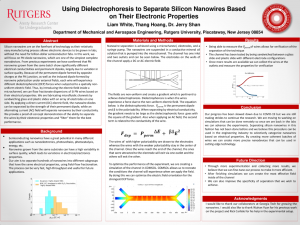White, Liam: Using Dielectrophoresis to Separate Silicon Nanowires Based on Their Electronic Properties
Title: Using Dielectrophoresis to Separate Silicon Nanowires Based on Their Electronic Properties
Name: Liam White
Major: Mechanical Engineering
School affiliation: School of Engineering
Programs: Aresty – RA Program
Other contributors: Thang Hoang
Abstract: Silicon nanowires are on the forefront of technology as their relatively easy manufacturing process allows electronic devices to be grown in labs, without the need for billion-dollar semiconductor fabs. In this work, we will focus on PN diode nanowires, which are one of the simplest complete nanodevices. From previous experiments we have confirmed that PN nanowires grown from the same batch show significantly different electrical conductivities and permanent dipoles, largely due to variation in surface quality. Because of the permanent dipole formed by opposite charges at the PN junction, as well as the induced dipole formed by nanowire polarization under external fields, each wire will experience different dielectrophoretic (DEP) forces when subjected to a spatially non-uniform electric field. Thus, by introducing the electric field inside a microchannel, we can flow fractionate dispersions of Si PN wires based on their electrical properties. We are fabricating microfluidic channels by sandwiching glass and plastic slides with an array of electrodes on one side. By applying a direct current (DC) electric field, the nanowire diodes can be separated by the strength of their permanent dipole, while an alternating current (AC) field will separate nanowires by their conductivity. We provide a proof-of-concept demonstration of the ability to separate the wires by their electronic properties and “filter” them for the best performance.
